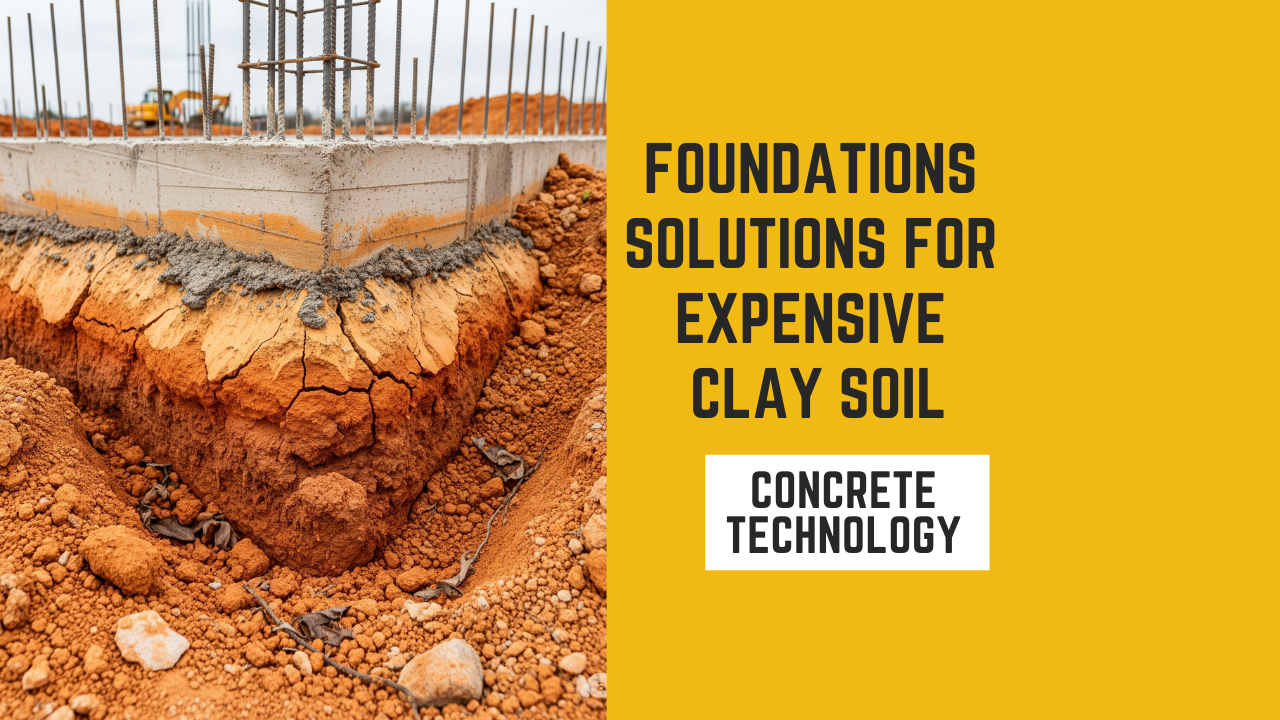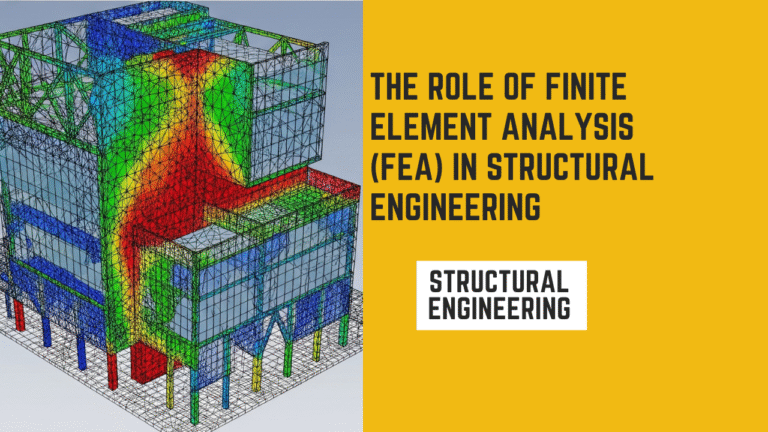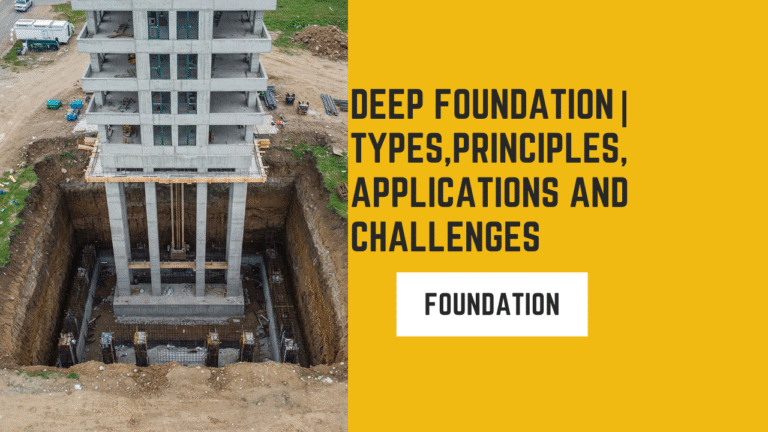Foundations solutions for expensive clay soil: Ultimate Guide

Introduction
Expensive clay soil – also called swelling clays- are a major headache for foundations worldwide. When they gain moisture they swell, when they dry they shrink. Those volume changes can lift, crack, or unevenly settle building foundations, pavements and slabs, causing costly repairs and long-term maintenance headaches. This article explains what expansive clays are, how to evaluate them, and presents practical foundation design and construction solutions you can use to control risk and improve long-term performance. ( Target audience:engineers, contractors and technically minded owners. )
What are expansive clay soils and why do they matter?
Expensive clay contain clay minerals ( commonly montmorillonite, smectite or mixed-layer clays) that attract water into their crystal structure and swell. The magnitude of swell depends on mineralogy, soil density and changes in moisture content caused by rainfall, irrigation, grading, or leaking utilities. The result differential heave and settlement that produce diagonal cracks in walls, stuck doors, uneven floors, and structural distress- especially in light framed or shallow foundations geotechnical testing (e.g explanation index,swell tests, Atterberg limits) is used to quantify the risk and guide design.
Early step: site investigation and testing
- A good mitigation plan starts with a thorough subsurface investigation .
- Boring and sampling to map the depth and lateral extent of expansive horizons. .
- Atteberg limit ( liquid limit, plastic limit ) plasticity index ( pl ) to indicate clay activity.
Swell tests/ one-dimensional consolidation tests/ ASTM D4829 ( Expansion Index) to directly measure expansion potential and magnitude. ASTM methods and state DOT procedures give standardized procedures for quantifying swell potential and classifying soils.
Accurate characterization tells you whether you can use shallow solutions ( moisture control, barriers, stabilization) or weather deeper remedial measures ( replacement, deep foundations) are required
Design and construction strategies (overview)
Controlling the moisture regime around the structure is the most reliable way to manage expansive soil behavior. Broadly, solutions fall into four families:
- Moisture control ( preventing wetting/drying cycles)
- Removal and replacement of problematic soils
- Soil improvement/ stabilization (chemical or mechanical)
- Deep Foundations systems (piles,piers, drilled shafts) or stiffened/mat foundations
Each approach has cost and conductibility trade offs that depend on building type, loads, depth of expansive soil, site drainage, and owner risk tolerance. Authoritative guidance and examples from government and DOT manuals recommend selecting the solution after site testing and cost-benefit analysis.
1) Moisture control: the first and most cost-effective defense
Because swelling is driven by moisture، the simplest long-term approach is to keep moisture near foundations constant
Surface drainage and grading: slope ground away from the structure ( typical 5% slope for first few meters) and use swales, gutters and downspouts to send water away
Perimeter drains and French drains: reduce ponding and lateral seepage into subgrade.
Capillary break and moisture barriers: polyethylene sheeting, geotextiles or low-permeability layers under slabs reduce moisture exchange between ground and structure.
Controlled landscaping and irrigation: avoid planting water-hungry trees close to foundations or deliberate over-watering. Use deep root barriers where trees must remain
Uniform irrigation strategy: if landscaping will introduce moisture cycles design irrigation to keep moisture uniform around the entire perimeter so differential movement is minimized
These measures rarely eliminate the need for structural precautions on highly active clays, but they significantly reduce risk for many projects and are
2) Remove and replace: the straightforward but sometimes costly fix
Where expansive clay zones are shallow and confined to a limited footprint, excavation and replacement with engineered non-expansive fill ( granular materials or compacted engineered fill) is ideal:
Where expansive clay zones are shallow and confined to a limited footprint, excavation and replacement with engineered non-expansive fill (granular materials or compacted engineered fill) is ideal:
- Excavate to a depth below active zone ( depth depends on soil, climate and vegetation) and backfill with approved granular material compacted to specification.
- Limit extent and depth by cost: removal is often economical for small residential lots but becomes costly for deep or widespread expansive horizons.
- Use geotextile separators and good compaction control to prevent contamination and long-term settlement
Removal & replacement eliminates the problem locally, but beware of edge effects- unplaced surrounding expansive soils can still cause differential movement if moisture control is not maintained
3) Chemical stabilization and soil modification
Chemical stabilization modifies the clay’s properties– typically reducing plasticity, swell potential and improving strength. Common binders and additives
- Lime ( calcium hydroxide or quicklime): effective for highly plastic clays. Lime reactions reduce plasticity and cause cation exchange and pozzolanic reactions that create cementitious products. Lime is widely used for subgrade stabilization
- Portland cement: increases strength and stiffness; best where sulfate levels are low or controlled. Cement can reduce swell but is not always a direct substitute for lime in all clay types—chemical behavior differs.
- Fly ash (Class C or Class F) and blended mixes (lime + fly ash): research shows lime + fly ash mixes can be very effective, often providing sustainable reuse of industrial byproducts while improving soil engineering properties. Recent studies support lime–fly ash blends for reducing plasticity and swell.
Practical notes: design and proportioning should be based on laboratory mix design and durability checks ( sulfate/alkali interactions). Stabilization can be applied in-situ using mixing or as treated borrow for engineered fill. Chemical stabilization is often more economical than full removal for larger areas.
4) Deep foundations,piers, and under-reamed piles
If expansive soils extend deep or the structure is sensitive (eg, heavy commercial or long-span), transfer loads to non-active strata with deep foundations.
- Piles and drilled shafts (friction or end-bearing): reach stable bearing layers below the active zone. Design must account for uplift or downdrag from volumetric changes in surrounding soil. State DOT guidance recommends avoidance of uplift loads by removal where possible; if not, design for them.
- Under-reamed piles / belled piers (used in some countries): provide mechanical interlock and resistance to uplift from heave; they are a common economical solution in residential construction where appropriate.
- Helical piles: useful for light-frame structures and where rapid loading and installation are desired.
Deep solutions are often more expensive up front but provide a durable, low-maintenance answer for important structures or where land use prevents effective moisture control.
5) Stiffened slabs, reinforced rafts and structural resilience
When deep foundations aren’t feasible, increasing the stiffness of the structural element so it can bridge differential movement is another strategy:
- Rigid reinforced concrete rafts/mats distribute loads and reduce differential movement effects. Design must consider expected differential strains and incorporate reinforcement and control joints accordingly. ASCE and specialty design guides describe rigid foundation design approaches for expansive soil sites.
- Post-tensioned slabs reduce cracking and can tolerate moderate differential movement.
- Strip footings with continuous beams (grade beams) + suspended slabs: separating the slab from the subgrade with a suspended floor system can isolate sensitive finishes from subgrade movement.
These structural approaches don’t stop underlying swell but protect the superstructure by redistributing internal strains—often used in combination with moisture control.
Best practices during construction
- Fallow geotechnical recommendations: foundation type, depth and backfill compaction should follow the project geotechnical report.
- Control moisture during construction: avoid allowing the subgrade to dry excessively before placing concrete, prevent ponding near foundations.
- Quality assurance for stabilized soils: lab test mixes, field density testing and on site verification of treatment depth and uniformity are essential
- Protect utilities and landscaping: design to avoid concentrated irrigation lines and plumbing near foundation lines; use robust leak detection and accessible routing to reduce risk of unexpected wetting.
Maintenance, monitoring and lifecycle thinking
Expensive soil projects demand lifecycle planning
- Regular Inspection: check for cracks, stuck doors, or water pooling
- Maintain drainage and gutters: keep perimeter drainage functioning for the life of the building
- Avoid future site changes: don’t alter irrigation or landscape or landscape designs that will produce asymmetric moisture changes around the foundation
- Instrumentation for critical projects: in sensitive infrastructure, inclinometers, settlement plates and moisture sensors can detect changes early and allow mitigations before damage accumulates.
Choose the right solution: a decision roadmap
- Start with geotechnical testing —map swell potential and depth. (ASTM D4829 and other standard tests.)
- If shallow and limited in area: consider removal & replacement plus moisture control.
- If deep or extensive expansive layers: consider deep foundations or stiffened structural systems.
- If cost-sensitive but large area: evaluate chemical stabilization (lime, cement, fly ash blends) with lab mix designs.
- Always combine with moisture management —even the best structural fix benefits from good drainage and moisture uniformity.
Conclusion
Expensive clay soils are manageable when approached with careful site investigation and the right mix of moisture control, soil improvement, structural design, and long-term maintenance. For small residential projects,moisture control plus selective replacement or stabilization often suffices. For critical or heavy structures, deep foundations or stiffened mats offer durable protection. Wherever possible, combine methods- engineering solutions plus good drainage and landscaping controls to reduce repair risk and lifecycle costs. Authoritative manuals and standards ( Army WBDG TM 5-818-7, FHWA references,ASTM methods and DOT manuals) provide practical,field-tested guidance to turn analysis into a safe, cost-effective foundation design.






